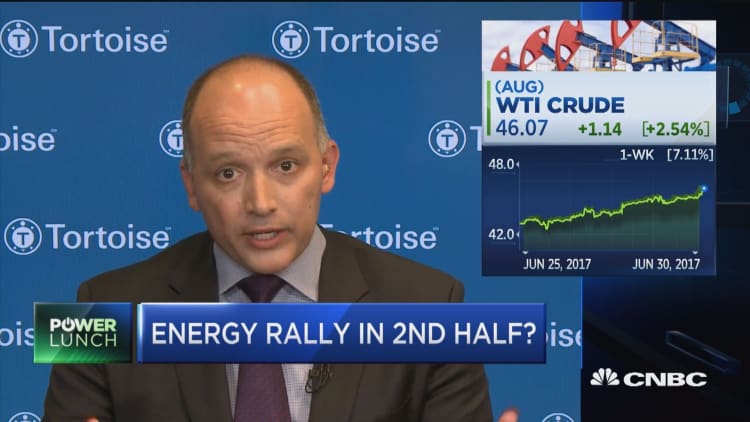Oil prices fell 3 percent in thin trading on Monday, as the geopolitical concerns that underpinned last week's rally faded.
Crude futures had risen in overnight trading, lifted by a drop in drilling activity in the United States and concerns that Washington could reintroduce sanctions against Iran, OPEC's third-biggest oil producer.
U.S. WTI crude futures ended Monday's session down $1.93, or 3 percent, at $63.01 a barrel, after finishing the first quarter up 7.5 percent.
Brent crude futures were down $1.59, or 2.3 percent, at $67.75 per barrel by 1:55 p.m. ET, having nearly touched the contract's 2018 high of $71.28 last week.
Trading volume was lower than normal as many countries were still on Easter holiday.
Tensions between Saudi Arabia and Iran, two of OPEC's top three crude producers, have somewhat receded, though traders were still covering bets that oil prices would fall heading into the long holiday weekend, analysts said.
"With nothing happening and no catalyst to keep it up here, you're starting to see this weak length coming out of the market," said John Kilduff, founding partner at energy hedge fund Again Capital.
"The anxiety just comes racing out of the market if nothing happens."
President Donald Trump has threatened to pull out of a 2015 international nuclear deal with Tehran under which Iranian oil exports have risen. He has given the European signatories a May 12 deadline to "fix the terrible flaws" of the deal.
Those concerns have been amplified by Trump's nominating Iran hardliner Mike Pompeo to be secretary of State and naming noted hawk John Bolton as national security advisor, said Tom Kloza, global head of energy analysis at Oil Price Information Service.
"Those two guys have probably propped up crude by a couple dollars a barrel, pending appointments or confirmation," he told CNBC.

Also potentially weighing on markets were rising trade tensions between the United States and China.
China increased tariffs by up to 25 percent on 128 U.S. products from Monday, escalating a spat between the world's biggest economies in response to U.S. duties on imports of aluminum and steel.
Oil has risen from a multiyear low near $27 in January 2016, helped by production cuts led by the Organization of the Petroleum Exporting Countries and Russia, which started in 2017 and are due to run until the end of 2018.
Russian oil output rose in March despite the output deal, to 10.97 million barrels per day from 10.95 million bpd in February, Russian Energy Ministry data showed, keeping Russia ahead of the United States as the world's biggest crude producer.
Trade sources told Reuters on Monday that top oil exporter Saudi Arabia is expected to cut prices for all crude grades it sells to Asia in May to reflect weaker prices for its Middle East benchmark Dubai crude.
"There is speculation that the Saudis are going to lower prices for their Asian customers," said Bob Yawger, director of energy futures at Mizuho in New York. "That is not really the kind of thing you do when you want to keep production cuts in place."

Output in Iraq, OPEC's second-biggest producer, has also been above the agreement, at around 5 million bpd in early 2018, versus the 4.4 million bpd stipulated in the deal. The Iraqi cabinet on Sunday approved a plan to raise the nation's crude oil output capacity to 6.5 million bpd by 2022.
"As the price ticks on up, the market gets concerned the OPEC and non-OPEC producers lose their enthusiasm to stick with the cuts," said Andrew Lipow, president at Lipow Oil Associates.
"At the same time, what we're seeing over here is production continue to ramp up, especially out of the Permian Basin, to the point where we are filling up all the pipeline capacity and are now waiting on additional pipelines to be put in service," he told CNBC, referring to the epicenter of the U.S. drilling rebound.
The revival in prices has helped to support a surge in U.S. drilling, which has boosted U.S. production to a record 10.43 million bpd, taking it past top exporter Saudi Arabia.
U.S. drillers cut seven oil rigs in the week to March 29, bringing the total down to 797, the first decline in three weeks. The rig count is closely watched as an indicator of future U.S. oil output.
— Reuters contributed to this story.


